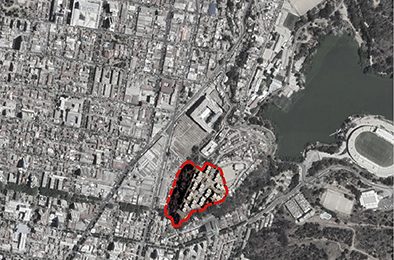Urban greeen areas in the reduction of cooling loads. Simulations in the Mediterranean climate
DOI:
https://doi.org/10.19229/2464-9309/11162022Keywords:
green infrastructures, nature-based solutions, urban green areas, reduction of cooling loads on buildings, urban frameworks in the Mediterranean climateAbstract
The fight against climate change and the right use of soil are two challenges on a global scale. The urbanization and the progressive reduction of green areas and permeable surfaces in urban settlements are amplifying some phenomena such as the increase of frequency and intensity of heatwaves and the annual average temperature, causing the growth of building energy demand. The paper examines the energy-saving potential that can be obtained by planting trees in outdoor spaces available around buildings for different urban frameworks in the Mediterranean climate. The data coming from the simulations, referred to residential sectors, expand the knowledge about the energy-environmental benefits of Green Infrastructures and are useful to guide sustainable practices of urban regeneration.
Downloads
Article Metrics Graph
References
Andreucci, M. B. (2017), Progettare Green Infrastructure – Tecnologie, valori e strumenti per la resilienza urbana, Wolters Kluwer, Italia.
Balogun, A. A., Morakinyo, T. E. and Adegun, O. B. (2014), “Effect of tree-shading on energy demand of two similar buildings”, in Energy Buildings, vol. 81, pp. 305-315. [Online] Available at: doi.org/10.1016/j.enbuild.2014.05.046 [Accessed 21 March 2022].
Calcerano, F. and Martinelli, L. (2016), “Numerical optimization through dynamic simulation of the position of trees around a stand-alone building to reduce cooling energy consumption”, in Energy Buildings, vol. 112, pp. 234-243. [Online] Available at: doi.org/10.1016/j.enbuild.2015.12.023 [Accessed 06 April 2022].
EEA – European Environmental Agency (2020), Urban adaptation in Europe – How cities and towns respond to climate change, EEA Report, no. 12/2020. [Online] Available at: eea.europa.eu/publications/urban-adaptation-in-europe [Accessed 21 March 2022].
European Commission (2021), The EU and nature-based solutions. [Online] Available at: ec.europa.eu/info/research-and-innovation/research-area/environment/nature-based-solutions_en [Accessed 21 March 2022].
European Commission (2020), Communication from the Commission to the European Parliament, the Council, the European Economic and Social Committee and the Committee of the Regions – A Renovation Wave for Europe – Greening our buildings, creating jobs, improving lives, document 52020DC0662, 662 final. [Online] Available at: eur-lex.europa.eu/legal-content/EN/TXT/?qid=1603122220757&uri=CELEX:52020DC0662 [Accessed 21 March 2022].
European Commission (2013), Building a Green Infrastructure for Europe, European Union. [Online] Available at: ec.europa.eu/environment/nature/ ecosystems/docs/green_infrastructure_broc.pdf [Accessed 21 March 2022].
Givoni, B. (1991), “Impact of planted areas on urban environmental quality – A review”, in Atmospheric Environment – Part B – Urban Atmosphere, vol. 25, issue 3, pp. 289-299. [Online] Available at: doi.org/10.1016/0957-1272(91)90001-U [Accessed 21 March 2022].
IEA – International Energy Agency (2018), The Future of Cooling – Opportunities for Energy-Efficient Air Conditioning. [Online] Available at: doi.org/10.1787/9789264301993-en [Accessed 21 March 2022].
Laband, D. and Sophocleus, V. (2009), “An experimental analysis of the impact of tree shade impacts on electricity consumption”, in Arboriculture & Urban Forestry, vol. 35, issue 4, pp. 197-202. [Online] Available at: doi.org/10.48044/jauf.2009.033 [Accessed 21 March 2022].
MEA – Millennium Ecosystem Assessment (2005), Ecosystems and Human Well-Being – Synthesis, Island Press, Washington (DC). [Online] Available at: millenniumassessment.org/en/Synthesis.aspx [Accessed 21 March 2022].
Mussinelli, E., Tartaglia, A., Bisogni, L. and Malcevschi, S. (2018), “Il ruolo delle Nature-Based Solutions nel progetto architettonico e urbano | The role of Nature-Based Solutions in architectural and urban design”, in Techne | Journal of Technology for Architecture and Environment, vol. 15, pp. 116-123. [Online] Available at: doi.org/10.13128/Techne-22112 [Accessed 24 January 2022].
Palme, M., Privitera, R. and La Rosa, D. (2020), “The shading effects of Green Infrastructure in private residential areas – Building Performance Simulation to support urban planning”, in Energy and Buildings, vol. 229, 110531, pp. 1-20. [Online] Available at: doi.org/10.1016/j.enbuild.2020.110531 [Accessed 21 March 2022].
Privitera, R., Evola, G., La Rosa, D. and Costanzo, V. (2021), “Green Infrastructure to Reduce the Energy Demand of Cities”, in Palme, M. and Salvati, A. (eds), Urban Microclimate Modelling for Comfort and Energy Studies, Springer, Cham, pp. 485-503. [Online] Available at: doi.org/10.1007/978-3-030-65421-4_23 [Accessed 21 March 2022].
Santamouris, M. and Kolokotsa, D. (2016), Urban Climate Mitigation Techniques, Routledge, London. [Online] Available at: doi.org/10.4324/9781315765839 [Accessed 21 March 2022].
Tiwari, A., Kumar, P., Kalaiarasan, G. and Ottosen, T.-B. (2021), “The impacts of existing and hypothetical green infrastructure scenarios on urban heat island formation”, in Environmental Pollution, vol. 274, 115898, pp. 1-14. [Online] Available at: doi.org/10.1016/j.envpol.2020.115898 [Accessed 21 March 2022].
UN – General Assembly (2015), Transforming our world – The 2030 Agenda for Sustainable Development, document A/RES/70/1. [Online] Available at: un.org/ga/search/view_doc.asp?symbol=A/RES/70/1&Lang=E [Accessed 10 November 2021].

Downloads
Published
Versions
- 18-11-2023 (2)
- 30-06-2022 (1)
How to Cite
Issue
Section
License
This Journal is published under Creative Commons Attribution Licence 4.0 (CC-BY).
License scheme | Legal code
This License allows anyone to:
Share: copy and redistribute the material in any medium or format.
Adapt: remix, transform, and build upon the material for any purpose, even commercially.
Under the following terms
Attribution: Users must give appropriate credit, provide a link to the license, and indicate if changes were made; users may do so in any reasonable manner, but not in any way that suggests the licensor endorses them or their use.
No additional restrictions: Users may not apply legal terms or technological measures that legally restrict others from doing anything the license permits.
Notices
Users do not have to comply with the license for elements of the material in the public domain or where your use is permitted by an applicable exception or limitation.
No warranties are given. The license may not give users all of the permissions necessary for their intended use. For example, other rights such as publicity, privacy, or moral rights may limit how you use the material.


















































































